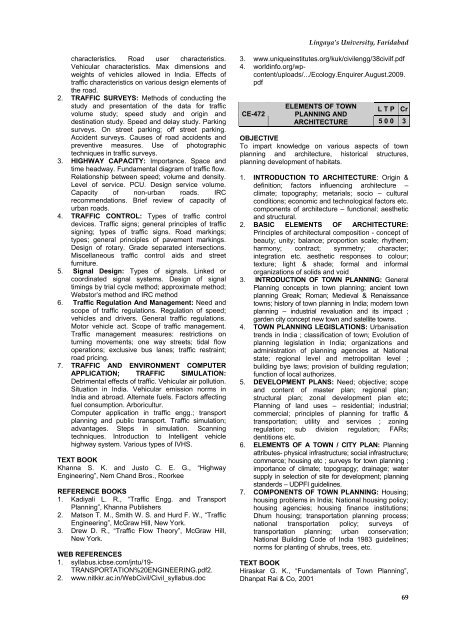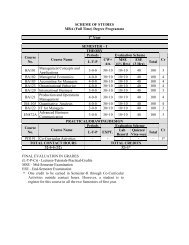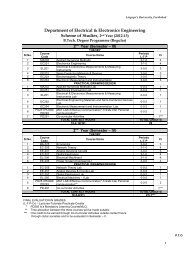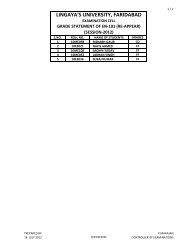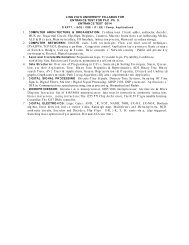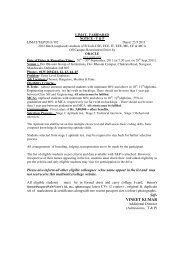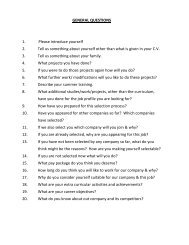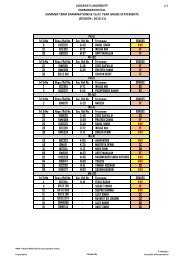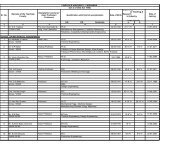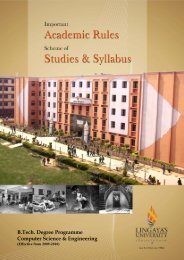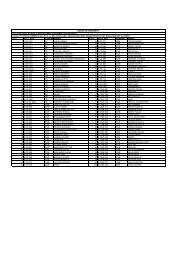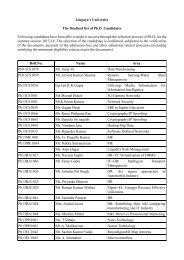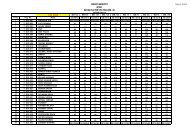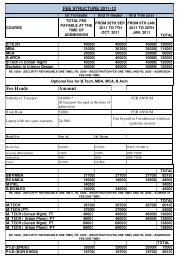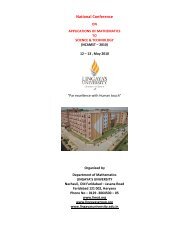B.<strong>Tech</strong>. <strong>Electrical</strong> <strong>Engineering</strong> (Regular)BA-271HUMAN RESOURCE L T P CrMANAGEMENT 5 0 0 3BA-272ENTREPRENEURSHIP L T P CrDEVELOPMENT 5 0 0 3OBJECTIVEThe course aims to provide the insights into effectivemanagement of human resources to enable thestudents to meet the HR challenges in the presentscenario.1. INTRODUCTION: Meaning, scope, objective,functions, policies & roles and importance ofHuman Resource Management; Interaction withother functional areas; HRM & HRD - acomparative analysis, organizing the HumanResource Management department in theorganization; Human Resource Managementpractices in India.2. HUMAN RESOURCE PLANNING: Definition,objectives; process and importance job analysis;Description, specification and job evaluation.3. DEVELOPING EFFECTIVE HUMAN RESOURCE:Recruitment; selection; placement and introductionprocess; human resource development: concept,employee training & development, career planning& development4. PERFORMANCE MANAGEMENT: concept andprocess, performance appraisal, Potentialappraisal Job Compensation: Wage & salaryadministration, incentive plans & fringe benefits;Promotions, demotions, transfers, separation,absenteeism and turnover; Quality of work life(QWL): Meaning, origin, development and variousapproaches and; to QWL, techniques for improvingQWL; Quality circles: concept, structure, role ofmanagement QC in India5. JOB SATISFACTION AND MORALE: Health,safety & employee welfare; counseling foreffective; enforcing equal employment opportunitylegislation; fair employment; fair practice laws,6. HUMAN RESOURCE DEVELOPMENT: HumanResource: definition, objectives & approaches tohuman relations; Employee grievances anddiscipline; participation & empowerment;Introducing to collective bargaining; HR Audit.7. HIGH PERFORMANCE WORK SYSTEM:Fundamental principles-Principle of shared info;principle of knowledge development; principle ofperformance reward linkage; principle ofEgalitarianism; Testing alignment of the HRsystem-HR deliverablesTEXT BOOKRao V. S. P., “Human Resource Management”, ExcelPublicationsREFERENCE BOOKS1. C. B. Memoria “Personal Management”, HimalayaPublications, New Delhi2. Edwin B. Flippo, “Personal Management” TataMcGraw Hill3. Aswathappa K., “Human Resource Management”,Tata McGraw Hill4. Dale Yoder, “Personnel Management & IndustrialRelations”, Tata McGraw HillOBJECTIVETo acquaint the students with the challenges of startingnew ventures and enable them to investigate,understand and internalize the process of setting up abusiness.1. CONCEPT OF ENTREPRENEURSHIP: meaningand characteristics of entrepreneurship,entrepreneurial culture, socio-economic origin ofentrepreneurship, factors affectingentrepreneurship, conceptual model ofentrepreneurship, traits of a good entrepreneur,entrepreneur, intra-preneur and manager2. ENTREPRENEURIAL MOTIVATION: motivating,compelling and facilitating factors, entrepreneurialambition, achievement motivation theory andkakinada experiment3. ESTABLISHMENT OF ENTREPRENEURIALSYSTEMS: search, processing and selection ofidea, Input requirements4. SMALL SCALE INDUSTRY: meaning, importance,characteristics, advantages and problems of SSIs.Steps for starting a small industry, guidelines forproject report, registration as SSI.5. ASSISTANCE TO SSI: need for incentives &subsidies, need for institutional support, role ofgovernment and other institutions.6. FUNCTIONAL PLANS: Marketing plan- marketingresearch for the new venture, steps in preparingmarketing plan, contingency planning;Organizational plan- Forms of ownership,designing organizational structure, job design,manpower planning; Financial plan- cash budget,working capital, proforma income statement,Proforma cash flow, proforma balance sheet, breakeven analysis.7. SOURCES OF FINANCE: Debt or Equityfinancing, commercial banks, venture capital;financial institutions supporting entrepreneurs;legal issues- intellectual property rights, patents,trade marks, copy rights, trade secrets, licensing,franchising.TEXT BOOKGupta C. B. and Srinivasan N. P., “EntrepreneurialDevelopment”, Sultan Chand & SonsREFERENCE BOOKS1. Vasant Desai, “Management of a Small ScaleIndustry”, Himalaya Publishing HouseCE-471ADVANCED TRAFFIC L T P CrENGINEERING 5 0 0 3OBJECTIVETo introduce the students about various modern trafficengineering and management problems and theirsolutions.1. INTRODUCTION AND TRAFFICCHRACTERISTICS: Objectives and scope oftraffic engg. Organisational set up of traffic enggdepartment in India. Importance of traffic68
Lingaya’s University, Faridabadcharacteristics. Road user characteristics.Vehicular characteristics. Max dimensions andweights of vehicles allowed in India. Effects oftraffic characteristics on various design elements ofthe road.2. TRAFFIC SURVEYS: Methods of conducting thestudy and presentation of the data for trafficvolume study; speed study and origin anddestination study. Speed and delay study. Parkingsurveys. On street parking; off street parking.Accident surveys. Causes of road accidents andpreventive measures. Use of photographictechniques in traffic surveys.3. HIGHWAY CAPACITY: Importance. Space andtime headway. Fundamental diagram of traffic flow.Relationship between speed; volume and density.Level of service. PCU. Design service volume.Capacity of non-urban roads. IRCrecommendations. Brief review of capacity ofurban roads.4. TRAFFIC CONTROL: Types of traffic controldevices. Traffic signs; general principles of trafficsigning; types of traffic signs. Road markings;types; general principles of pavement markings.Design of rotary. Grade separated intersections.Miscellaneous traffic control aids and streetfurniture.5. Signal Design: Types of signals. Linked orcoordinated signal systems. Design of signaltimings by trial cycle method; approximate method;Webstor’s method and IRC method6. Traffic Regulation And Management: Need andscope of traffic regulations. Regulation of speed;vehicles and drivers. General traffic regulations.Motor vehicle act. Scope of traffic management.Traffic management measures: restrictions onturning movements; one way streets; tidal flowoperations; exclusive bus lanes; traffic restraint;road pricing.7. TRAFFIC AND ENVIRONMENT COMPUTERAPPLICATION; TRAFFIC SIMULATION:Detrimental effects of traffic. Vehicular air pollution.Situation in India. Vehicular emission norms inIndia and abroad. Alternate fuels. Factors affectingfuel consumption. Arboricultur.Computer application in traffic engg.; transportplanning and public transport. Traffic simulation;advantages. Steps in simulation. Scanningtechniques. Introduction to Intelligent vehiclehighway system. Various types of IVHS.TEXT BOOKKhanna S. K. and Justo C. E. G., “Highway<strong>Engineering</strong>”, Nem Chand Bros., RoorkeeREFERENCE BOOKS1. Kadiyali L. R., “Traffic Engg. and TransportPlanning”, Khanna Publishers2. Matson T. M., Smith W. S. and Hurd F. W., “Traffic<strong>Engineering</strong>”, McGraw Hill, New York.3. Drew D. R., “Traffic Flow Theory”, McGraw Hill,New York.WEB REFERENCES1. syllabus.icbse.com/jntu/19-TRANSPORTATION%20ENGINEERING.pdf2.2. www.nitkkr.ac.in/WebCivil/Civil_syllabus.doc3. www.uniqueinstitutes.org/kuk/civilengg/38civilf.pdf4. worldinfo.org/wpcontent/uploads/.../Ecology.Enquirer.August.2009.pdfCE-472ELEMENTS OF TOWNL T P CrPLANNING ANDARCHITECTURE 5 0 0 3OBJECTIVETo impart knowledge on various aspects of townplanning and architecture, historical structures,planning development of habitats.1. INTRODUCTION TO ARCHITECTURE: Origin &definition; factors influencing architecture –climate; topography; metarials; socio – culturalconditions; economic and technological factors etc.components of architecture – functional; aestheticand structural.2. BASIC ELEMENTS OF ARCHITECTURE:Principles of architectural composition - concept ofbeauty; unity; balance; proportion scale; rhythem;harmony; contract; symmetry; character;integration etc. aesthetic responses to colour;texture; light & shade; formal and informalorganizations of solids and void3. INTRODUCTION OF TOWN PLANNING: GeneralPlanning concepts in town planning; ancient townplanning Greak; Roman; Medieval & Renaissancetowns; history of town planning in India; modern townplanning – industrial revaluation and its impact ;garden city concept new town and satellite towns.4. TOWN PLANNING LEGISLATIONS: Urbanisationtrends in India ; classification of town; Evolution ofplanning legislation in India; organizations andadministration of planning agencies at Nationalstate; regional level and metropolitan level ;building bye laws; provision of building regulation;function of local authorizes.5. DEVELOPMENT PLANS: Need; objective; scopeand content of master plan; regional plan;structural plan; zonal development plan etc;Planning of land uses – residential; industrial;commercial; principles of planning for traffic &transportation; utility and services ; zoningregulation; sub division regulation; FARs;dentitions etc.6. ELEMENTS OF A TOWN / CITY PLAN: Planningattributes- physical infrastructure; social infrastructure;commerce; housing etc ; surveys for town planning ;importance of climate; topograpgy; drainage; watersupply in selection of site for development; planningstanderds – UDPFI guidelines.7. COMPONENTS OF TOWN PLANNING: Housing;housing problems in India; National housing policy;housing agencies; housing finance institutions;Dhum housing; transportation planning process;national transportation policy; surveys oftransportation planning; urban conservation;National Building Code of India 1983 guidelines;norms for planting of shrubs, trees, etc.TEXT BOOKHiraskar G. K., “Fundamentals of Town Planning”,Dhanpat Rai & Co, 200169
- Page 1 and 2:
B.Tech. Degree ProgrammeElectrical
- Page 5 and 6:
Lingaya’s University, FaridabadAB
- Page 7 and 8:
IMPORTANT ACADEMIC RULESB.Tech. Deg
- Page 9 and 10:
Lingaya’s University, Faridabadac
- Page 11 and 12:
Lingaya’s University, FaridabadSe
- Page 13 and 14:
Lingaya’s University, FaridabadIn
- Page 15 and 16:
CATEGORY-WISE LIST OF COURSESLingay
- Page 17 and 18:
Lingaya’s University, FaridabadSU
- Page 19 and 20:
Lingaya’s University, FaridabadSc
- Page 22 and 23: B.Tech. Electrical Engineering (Reg
- Page 24 and 25: B.Tech. Electrical Engineering (Reg
- Page 26 and 27: B.Tech. Electrical Engineering (Reg
- Page 28 and 29: B.Tech. Electrical Engineering (Reg
- Page 30 and 31: B.Tech. Electrical Engineering (Reg
- Page 32 and 33: B.Tech. Electrical Engineering (Reg
- Page 34 and 35: B.Tech. Electrical Engineering (Reg
- Page 36 and 37: B.Tech. Electrical Engineering (Reg
- Page 38 and 39: B.Tech. Electrical Engineering (Reg
- Page 40 and 41: B.Tech. Electrical Engineering (Reg
- Page 42 and 43: B.Tech. Electrical Engineering (Reg
- Page 44 and 45: B.Tech. Electrical Engineering (Reg
- Page 46 and 47: B.Tech. Electrical Engineering (Reg
- Page 48 and 49: B.Tech. Electrical Engineering (Reg
- Page 50 and 51: B.Tech. Electrical Engineering (Reg
- Page 52 and 53: B.Tech. Electrical Engineering (Reg
- Page 54 and 55: B.Tech. Electrical Engineering (Reg
- Page 56 and 57: B.Tech. Electrical Engineering (Reg
- Page 58 and 59: B.Tech. Electrical Engineering (Reg
- Page 60 and 61: B.Tech. Electrical Engineering (Reg
- Page 62 and 63: B.Tech. Electrical Engineering (Reg
- Page 64 and 65: B.Tech. Electrical Engineering (Reg
- Page 66 and 67: B.Tech. Electrical Engineering (Reg
- Page 68 and 69: B.Tech. Electrical Engineering (Reg
- Page 71: OPEN ELECTIVELingaya’s University
- Page 75 and 76: Lingaya’s University, Faridabad4
- Page 77 and 78: Lingaya’s University, Faridabad6.
- Page 79 and 80: Lingaya’s University, FaridabadEL
- Page 81 and 82: Lingaya’s University, Faridabad5
- Page 83 and 84: Lingaya’s University, Faridabador
- Page 85 and 86: Lingaya’s University, Faridabad4.
- Page 87: Lingaya’s University, Faridabad83


